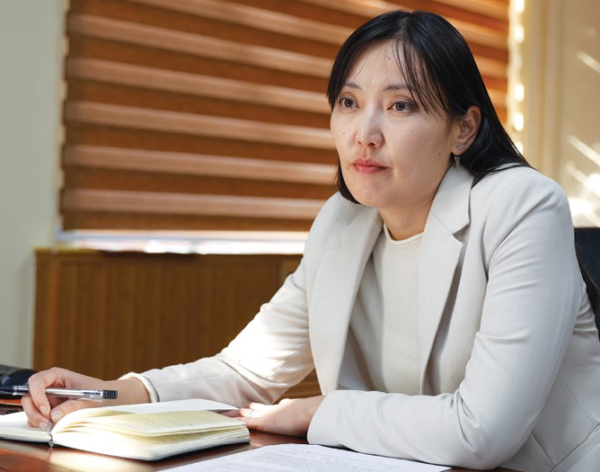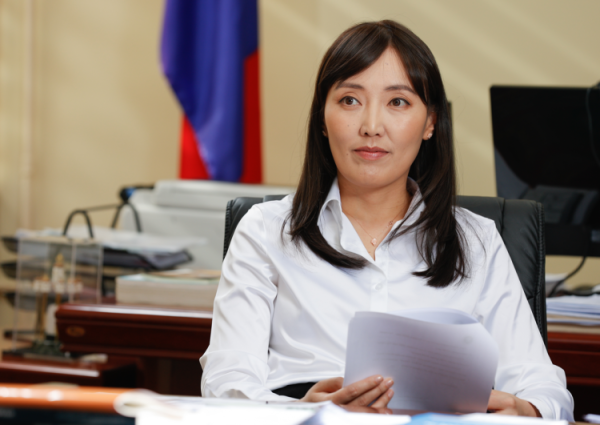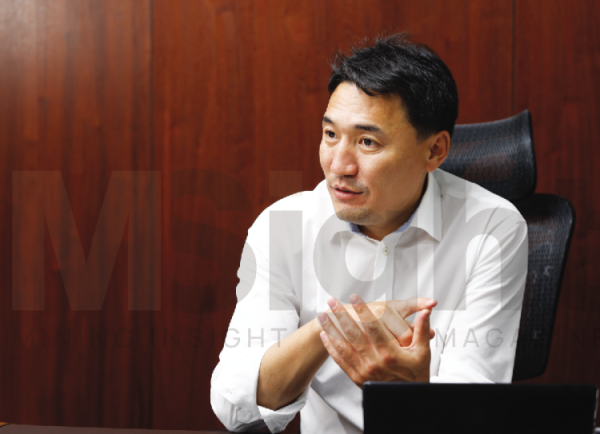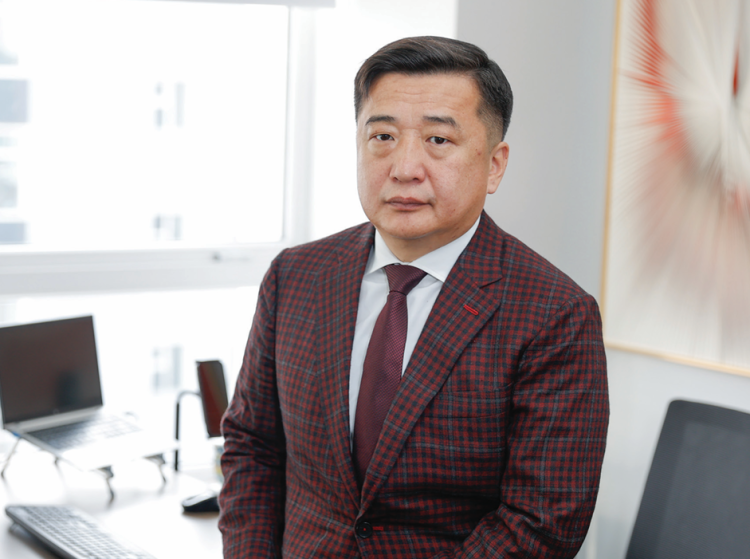 Mining Insight’s Sukhbat. N interviewed Uyanga. B, the Deputy Minister of Mining and Heavy Industry. While she has recently assumed the role of Deputy Minister, she brings with her several years of experience in pivotal roles at the policy and regulation levels within the mining industry.
Mining Insight’s Sukhbat. N interviewed Uyanga. B, the Deputy Minister of Mining and Heavy Industry. While she has recently assumed the role of Deputy Minister, she brings with her several years of experience in pivotal roles at the policy and regulation levels within the mining industry.
BY 2024, A COMPREHENSIVE SURVEY WILL COVER 10 PERCENT OF THE TERRITORY
Given your experience at the policy level of the Ministry of Mining and Heavy Industry (MMHI), how do you perceive the current situation and challenges within the mining sector?
The mineral sector undergoes distinct phases marked by cycles. In the exploration stage, the private sector assumes the risk of searching for underground resources. If a field is discovered, only a limited number of companies meet the criteria for exploitation. Those who meet the criteria face investment challenges. Once they have them all set, then they progress through mining, concentration, and, if possible, processing. Then, of course, the products are exported, ultimately contributing to the country’s economy. In my experience working at the MMHI, I’ve observed that our country has implemented and modified numerous policies throughout its development within this significant cycle. However, when encountering challenges, there’s a tendency to pause and adopt alternative approaches rather than overcoming the issues at hand. In certain instances, it appears that methods initially suitable for us have veered off course due to collisions with the global economic cycle. Following the acquisition of a sample through an exploration license, the next step involves uncovering and discovering a deposit upon the issuance of said permit. The conventional approach involves conducting exploration activities with private investments rather than relying on the state budget. This method has been the preferred route in Mongolia. Since the initiation of the Minerals Act of 1997, approximately 14,000 special licenses have been issued for exploration. However, in comparison to the current number of active operating licenses, it appears that only a small fraction, perhaps 1 in 100 exploration licenses, have transitioned into operational phases. Upon my arrival in Mongolia, I observed a conflation of exploration with exploitation. In the natural progression of the mining cycle, as it transitions from exploration to exploitation and enters the economic cycle, intentional disruptions become apparent. Additionally, projects may face obstacles in implementation due to politicization, with the industry being wielded as leverage in certain scenarios. Consequently, a common outcome is the hesitance of investments, driven by an atmosphere of caution. Furthermore, the flexibility of the Minerals Law and the frequent changes in the Budget Law, fluctuating back and forth, contribute to an environment of uncertainty. Such conditions do not rule out the possibility that investors may choose to refrain from entering the market due to perceived risks and a sense of hopelessness.
There is a crucial need to attract investment in the exploration sector.
Given our country’s vast land area, small population, and abundant geological resources, there is significant potential for the development of the mining industry. Regrettably, investors have been deterred. In contrast, neighboring Kazakhstan, with similar geological potential and proximity, has successfully attracted investments, leading to the opening of numerous deposits. Despite economic similarities, they, too, were once under external influences, but they have recognized and capitalized on the underground resources available. Unfortunately, our exploration efforts came to a halt between 2010 and 2014, closing the opportunity window for utilizing that 1 in 100 ratio for four years. If exploration had continued during that period, valuable information could have been uncovered, aiding in the decision-making process regarding whether to proceed with operationalization or not. It’s akin to a missed opportunity or a period with unexplored potential. Exploration extends beyond the search for solid minerals like gold and copper; it also involves gathering data on liquid minerals and underground water. These aspects are integral components of the exploration process. Working at the policy level necessitates a collaborative approach, emphasizing teamwork, accurate information dissemination, and utilizing multiple communication channels. It is crucial to ensure clarity, notably conveying that a special exploration license differs distinctly from an exploitation license.
The discussion surrounding the revision of the Law on Minerals has been ongoing since 2019, triggered by constitutional amendments. How is it going with the revision?
I collaborated with a team at the MMHI for the revision of the Law on Minerals. It is currently at a standstill. There is optimism and anticipation that the working group will successfully submit it for further consideration. Proactively, we engaged in discussions on the draft law both before its conceptual approval and subsequently after receiving approval. Following the conceptual approval by Ganbaatar Jambal, Minister of Mining and Heavy Industry, it is anticipated that valuable proposals for law implementation will surface. Recognizing the importance of incorporating such suggestions, there were discussions about examining the concept before formal approval. However, the Bar Association expressed opposition. The accuracy of the stage at which it must be approved and discussed remains uncertain.
 There is great anticipation for the revision of the Law on Minerals within the industry. What fundamental changes and reforms are envisaged in state regulations to enhance the mining sector? What specific issues are targeted for resolution to propel the industry forward?
There is great anticipation for the revision of the Law on Minerals within the industry. What fundamental changes and reforms are envisaged in state regulations to enhance the mining sector? What specific issues are targeted for resolution to propel the industry forward?
The central principle is accountability. It is our responsibility that the mining industry is not adequately comprehended by the general public. Some enterprises may act irresponsibly. As the saying goes, “If you don’t build a pile, what will the magpie sit on?” It could be that they failed to communicate and clarify their operations in the local community, did not make sufficient efforts, and neglected their duties. We must rectify these errors. The guiding principle is to establish accountability mechanisms at every stage. Examining the legal landscape in neighboring countries, China’s Natural Resources Law of 1988 has seen minimal changes. The Russian Federation operates under two laws: the Law on Subsoil and the Law on Precious Metals, both approved before 2000 and subjected to only a few amendments. Kazakhstan’s Subsoil Law encompasses all minerals—solid, liquid, and radioactive. This law underwent revision in 2017 to align with Australian law, resulting in a thriving industry that has effectively attracted investments since then. Our Minerals Law was initially approved in 1994 and underwent reorganization in 1997 with the issuance of exploration licenses to both individuals and enterprises. However, the 2006 revision restricted the issuance to enterprises only. Currently, it follows this revised legal framework. In contrast, the legal frameworks of other regions, particularly in Eurasia, appear more stable. Investors evaluating opportunities in Eurasia may be hesitant to choose ours, given the importance they place on the stability of the legal environment when assessing risks. On the flip side, our legal framework is distinctly categorized for each type of mineral. Following the 2006 revision of the Minerals Law, liquid minerals or water were differentiated under the Law on Water. Subsequently, a segment was further distinguished due to widespread distribution. In 2010, with the cessation of exploration license issuance, a specific law was enacted for Minerals of Widespread Distribution in 2012. Radioactive minerals were later separated under the Nuclear Energy Law. However, upon the introduction of a long-named law, certain aspects were prohibited.
Simultaneously, small-scale mining was allowed by creating an avenue for communities to obtain small-scale mining licenses. This highlights the instability of the legal environment, with minerals being explored and utilized without a unified concept. Moreover, there have been over 300 amendments to the Minerals Law since 2006. Approval of a law, when accompanied by numerous changes, presents a challenge. The members of the Working Group, tasked with revising the Minerals Law, conducted research and discovered that the original concept was no longer aligned with the current one. The industry is cognizant of this issue, not oblivious. In 2017, the Ministry of Justice investigated the contradictions and overlaps within the legal framework of the mining sector, revealing numerous duplications, contradictions, and overlaps, highlighting problematic and unregulated relations. Based on these findings, it was deemed imperative to initiate the revision of the Law on Minerals. As part of the revision to the Law on Minerals, the proposal is to cease regulating widely distributed minerals through a separate law. Instead, a comprehensive law is suggested, aligning with the law’s concept, to regulate the rights to explore and utilize minerals in specific areas according to the Law on Minerals. Additionally, there is a proposal to encompass the entire process, from the nuclear energy law to the production of yellow powder, within the framework of the Minerals Law. Furthermore, as part of enhancing accountability, there is a proposal to broaden the scope of mine closure within the framework of the law. The suggestion is to institute early arrangements for closure planning, ensuring the allocation of a designated amount of funds annually specifically earmarked for closure purposes. Having worked under the Minerals Law for the past 18 years since 2006, I have become accustomed to this environment. Nevertheless, I express the hope that the law will be approved with a sense of responsibility and thorough consideration.
The global interest in exploring critical elements, identified as future minerals, is surging, with a substantial increase in international exploration investments. Conversely, exploration investment within our country has markedly declined. What steps should our nation take to bolster the intensive development of its exploration sector, and what specific activities are planned? Additionally, what initiatives is the MMHI currently undertaking to address this situation?
Acquiring reliable baseline geological data is essential to facilitate the exploration of critical minerals and to attract investment.
Many of the sizable deposits currently in use were discovered in the 1990s, coinciding with comprehensive geological research efforts. However, budget constraints limit ongoing renewal. While successive ministers have allocated funds for basic geological research, this process has been interrupted, particularly in the critical phase of exploration required to discover deposits during the geological survey. In 2024, there is a concerted effort to significantly enhance basic geological research, with a relatively larger budget allocated in the State budget compared to previous years. An innovative approach in this endeavor involves the short-term aerial measurement of the physical properties of rocks. The goal is to survey 10 percent of the territory using this method by 2024. Collaboration between Mongolian and international companies is encouraged, extending beyond mineral prospects. The information obtained will not only include details about significant mineral deposits but also identify large, deep cracks in the ground, serving as an indicator for potential earthquakes. This initiative has broader implications for various aspects of life quality. I am committed to initiating this work with a focus on quality, as the preparation of data meeting modern requirements will boost confidence and attract investment in the field of exploration. Conducting thorough foundational research and creating entry opportunities positions us as a country with promising prospects. Following Russia and preceding Kazakhstan, diligent research and successful attraction of exploration investments should lead to the discovery of valuable deposits. The subsequent decision on whether to fully exploit these resources remains a challenge for us to address. There is a call for economic diversification, and the financial means for such diversification could potentially stem from the mineral sector. Our industry should play a pivotal role by compiling essential data to steer us in the right direction. Is it accurate to state that the initiation of digital data preparation with new technology was undertaken last year by Xcalibur LLC? This form of research is slated for a trial in 2023, with plans for expansion in 2024. Xcalibur serves as an initial example, and various organizations from Canada and other countries have expressed interest in conducting research with us.
Our aim is to collaborate with Mongolian companies, enhancing the expertise and communication skills of our professionals. With the update of geological information, how does the revision of the Minerals Law create new avenues for attracting investment within the legal environment? Although more closely related to investment law, the challenges in our industry are predominantly regulated by the Law on Minerals. If the timely approval of the law is not achieved and the existing law persists, the issuance of exploration licenses will continue through a selection process. One noteworthy accomplishment by the MMHI is the complete digitization of the issuance of exploration licenses. This process is currently underway on the public procurement platform https://www.tender.gov. mn/, which has been developed over the past decade. Instead of creating a new platform independently, collaborative efforts from various government institutions have resulted in a high-quality platform with robust security measures, resistant to external attacks. This platform facilitates the announcement of thousands of selections daily. Up until 2022, a positive trend was evident as the funds entering the state budget from the exploration selection process exceeded expectations by a significant percentage. This success highlights the potential for collaborative efforts among government organizations, showcasing numerous opportunities for impactful initiatives.
ANTICIPATING A SURGE IN THE REGISTRATION OF LITHIUM DEPOSITS
As a response to the global energy transition, nations worldwide are reassessing and redefining their mineral resource sectors, production methods, raw material consumption, and supply chains. Industry experts emphasize the imperative for Mongolia to revise its mining policy and strategy to align with these evolving trends and future changes. Could you please provide insights into the policy and planning direction that the Ministry is undertaking in response to this perspective? The focus on transforming critical minerals in Mongolia is crucial. The determination of international importance for minerals is predominantly influenced by consumer countries, in essence, the producing countries. If the required raw materials for production are not locally available, they are classified as critical raw materials and receive policy support to be obtained from reliable sources. For instance, South Korea may identify minerals essential for battery production as critical, signaling the necessity to secure these resources from dependable outlets. As a nation primarily focused on extraction without significant product manufacturing, it poses a challenge to assess the economic importance of certain minerals. However, manufacturing countries must align their focus with minerals deemed crucial by other nations and those anticipated to drive future demand.
We are actively expanding our international cooperation in this regard, and it is proving to be effective.
Our unique geopolitical position facilitates joint entry with other nations. An illustration of this collaborative approach is our cooperation with South Korea, the United States, and Poland. Last summer, a memorandum of cooperation was signed with the United States, and before that, a similar memorandum was established with the Korean side during the Prime Minister’s visit to South Korea. Moving forward, regular tripartite meetings are planned, where private sector projects requiring investment will be presented at each session. As a result of the collaboration with the United States, joint research endeavors with Erdenes Mongol have commenced. Fieldwork in conjunction with Polish researchers has been conducted during 2022- 2023, and the results are imminent. Additionally, in collaboration with the Korea Institute of Geoscience and Mineral Resources (KIGAM), a state-funded study has undertaken supplementary research in areas potentially rich in rare metals. The project report is anticipated to be released soon, and there is optimism for positive outcomes. Careful consideration is essential. Minerals hold value and utility only when in demand. Once the demand diminishes, profitability follows the same trajectory. Hence, it is imperative to discern and focus on minerals that are currently in demand. In South Korea, successful research on materials to replace metallurgical coal in the coke industry is notable. Considering the potential introduction of a material capable of generating high temperatures into production, it raises the question of whether, in the future, our metallurgical coal might be utilized similarly to its current application in the coke industry. This prompts the need to reassess its classification as a mineral. The four elements—lithium, nickel, cobalt, and graphite—are commonly discussed as essential components for batteries. However, international research on materials to replace lithium is progressing rapidly. While efforts are underway to find and extract lithium deposits, the emergence of alternatives could render lithium obsolete. It’s disheartening to consider opening a deposit for perceived profitability only to find it unused due to evolving technologies. Additionally, advancements in extracting cells from discarded batteries are noteworthy. It is commendable that our scientists collaborate to separate lithium from used batteries, even though our country currently lacks a significant presence of electric cars.
What progress has been made in establishing a research center for rare earth metals, and what potential benefits and effects are anticipated with the establishment of this research center?
with the establishment of this research center? An agreement has been reached to establish a research center for rare earth metals through a 5-year grant from South Korea. The Korean investment organization is collaborating with the Central Geological Research Laboratory, formerly known as our Central Geological Laboratory. The initial plan involves constructing a facility and installing laboratory equipment. To fortify the foundation of our country’s laboratories and enhance the expertise of our professionals, a proposal was put forth to collaborate with the Central Geological Laboratory. Following mutual understanding and approval, necessary agreements have been finalized. The laboratory equipment is expected to arrive in the first quarter of this year, with the first two years dedicated to installation and orientation activities. Laboratory samples for technical and economic feasibility studies, as well as additional exploration work on rare earth metal deposits, have been sent abroad. The establishment of a local laboratory in Mongolia will enable the conduct of these laboratory works domestically. Additionally, plans include the construction of a substantial beneficiation laboratory to research ore beneficiation properties. Moreover, there is a conceptualization of state laboratory oversight for external quality control. Over the course of 5 years, Korean laboratory experts will facilitate knowledge transfer, allowing our local experts to gradually assume control. This approach is anticipated to enhance the capabilities of our experts. Furthermore, the involvement of Korean investors in exploration and research activities with the research center is foreseen. The credibility and trust in laboratory results are expected to attract more investors, fostering an increase in their participation.
What recent developments or anticipated openings of new deposits have taken place in recent years?
Upon reviewing the exploration projects submitted to the Minerals Professional Council for reserve estimation, a notable trend is the increase in polymetallic projects. Recently, there has been a surge in projects encompassing gold, silver, lead, and polymetallic elements. An intriguing observation is the anticipation of actively recording reserves for lithium deposits in the near future. Following the concept of discovering one deposit after another, the activation of exploration often ensues. Consequently, there is a rapid influx of projects related to battery raw materials, as well as a notable presence of widespread mineral projects.
In terms of project scale, a significant one on our radar is Erdene Mongol (ERD)’s project in Bayankhongor province.
This project marks a completely new discovery in an ore district that had previously remained undiscovered. The identification of such a substantial deposit in an unexplored ore district suggests the potential for additional discoveries in the surrounding areas. Furthermore, there is ongoing exploration for a completely new lithium deposit, and we are optimistic about the prospect of obtaining interesting results.
In recent years, there has been a limited number of commissioned projects in the mining sector. How do you perceive the situation where substantial projects, which have been under discussion for an extended period and are technically prepared, are encountering obstacles, hindering their economic activation?
Current statistics reveal a disparity between exploration and exploitation licenses, with the majority of large undeveloped deposits relying on investment and essential infrastructure, notably in the energy sector. We recognize the need to enhance our regulatory role. Starting in 2022, a strategic shift has been made towards actively showcasing our private sector projects on the international stage to attract investments. Mongolia has engaged in events like PDAC and IMARC to present its legal framework, fundamental geological research data, and pre-established projects. It’s noteworthy that the Mineral Resources and Petroleum Authority of Mongolia (MRPAM), after a prolonged hiatus, has resumed the development of its field. This year marks the second consecutive participation of the Mongolian field at PDAC. Acknowledging the challenges stemming from insufficient investment, efforts are being directed toward engaging license holders who furnish reports on mining and exploration work. Presentations to investors are being actively pursued, with a realistic understanding that improvements will not materialize overnight merely from today’s presentations.
The mining industry has consistently held a distinctive position in Mongolia, yet the opinions within our society regarding its impact on both the economy and society vary. Is the initiation of a new mining operation a subject of particular controversy?
This initiative aimed to illuminate the distinction between exploitation and exploration, with a particular project serving as a test case. Collaborating with the Australian AMEP project, three wells were selected within a substantial number of licenses, and an awareness training program on geological exploration was executed. Given the attentive nature with which individuals listen to their children, we recognized the potential for a more significant impact on understanding the industry among young people. Therefore, we incorporated step-by-step courses specifically designed for high school students. A positive outcome of this project is the heightened aspiration among almost all high school students to pursue careers as geologists and mining engineers. This experience highlights the importance of conducting similar projects, as it appears that the root cause of misconceptions may be attributed to a lack of information or potential barriers to access.
In your opinion, what are the key issues that must be prioritized to ensure the sustained success and minimal risk of mining projects?
The mining sector operates continuously, exports will persist uninterrupted, ensuring a continuous influx of money into the economy. Consequently, numerous incentives are essential to sustain the mining industry, which involves high fuel consumption, the use of various chemicals in concentrators, and the necessity for purchasing blasting materials from abroad. Last December, the mining industry faced restrictions and halts within a certain range due to a shortage of fuel. Similarly, during the Covid period, planned activities were disrupted due to a shortage of chemicals. Consequently, at the ministry level, discussions are underway on addressing the excessive dependence on fuel, chemicals, and explosives, with an active search for viable solutions. Individuals in our industry, with extensive government service experience, are observing a noteworthy development – an unprecedented enhancement in cooperation among government institutions. Specifically, in addressing fuel-related issues, our ministry is closely collaborating with the Ministry of Road and Transport Development to streamline logistics, contrasting with a time when planning seemed disjointed and disconnected. The successful collaboration extends not only to government institutions but also to the private sector. The crucial aspect is ensuring the preservation of this collaborative effort.
You have introduced a plan to develop geopark, which is the foundation for geo-tourism at TEDx during Mining Week 2022. How favorable are the conditions for establishing a geopark in our country, and what initiatives are underway to facilitate the development of the Geopark?
This is one of the initiatives I aimed to undertake upon assuming the role at the MMHI. The Geopark concept offers a distinctive perspective for our industry, bridging knowledge derived from the beauty of nature and its integration with culture. There is untapped potential within the mining sector. In 2018, our predecessors extensively deliberated on this, moving towards showcasing the scenic wonders of Mongolia. The potential for developing a geopark in Mongolia is evident. China’s statistics indicate not only its feasibility but also its potential benefits. China’s robust growth in domestic tourism in recent years is closely linked to geoparks. The registration of numerous geoparks with UNESCO and the expansion of tourism routes have contributed to an annual economic growth related to tourism ranging from 5-7 percent. With the official announcement of 2023-2025 as the “Year to Visit Mongolia,” there was a significant influx of tourists last year. By showcasing our unique and beautiful destinations, disseminating information through various channels, and elevating them to global standards, we can anticipate not only an increase in foreign tourism but also a surge in domestic tourism. Moreover, catering to the preferences of educated tourists seeking to enhance their knowledge during their travels would be a valuable aspect. To establish a geopark, the identification and registration of special geological sites with UNESCO are imperative. The process involves the establishment of a national committee to engage with UNESCO. In the previous year, a National Committee was constituted, comprising representatives from the Ministry of Mining and Heavy Industry, the Ministry of Environment and Tourism, the Ministry of Foreign Affairs, the Ministry of Economy and Development, and pertinent government organizations. Subsequently, comprehensive information was submitted to UNESCO, signifying the groundwork. The Department of Geological Policy within the Ministry of Mining and Heavy Industry is currently preparing the requisite documentation for UNESCO registration.
I recall your mention of the Ministry of Mining and Heavy Industry’s intent to conduct a study on potential geopark sites. Has this research been conducted, and if so, could you kindly share the results with us?
There are numerous captivating geological formations in Mongolia and one of the prime candidates for UNESCO registration is Khanbogd Soum in Umnugovi province. In addition to the Oyu Tolgoi deposit in Khanbogd Soum, there exists a location rich in fossils and dinosaur traces known as Shar Tsav. Discussions have been ongoing since 2018 regarding the UNESCO registration of this site. The National Committee visited the area last year to determine which aspects to highlight. Adjacent to the Oyu Tolgoi deposit, on the left side, is a sizable granite formation called Khanbogd Passive, showcasing a beautiful formation with rare metals. In Shar Tsav, funds have been allocated from the state budget, with support from the Governor of Umnugovi Province, leading to the construction of a training facility. As part of the geopark development initiative, five young geologists were interviewed by the Geological Survey of Japan and provided with the opportunity to gain experience in Japanese geoparks. Additionally, a young geologist is currently undergoing training in Turkey in the field of geopark management. Based on China’s experience, registering natural beauty spots as UNESCO Geoparks serves as free advertising. If Shar Tsav is designated a UNESCO Geopark, it can attract tourists, foster tourism development, and generate job opportunities locally. Similar to the positive impact observed in China, the development of geoparks can contribute to reducing the migration of people toward urban centers. We have numerous potential locations that could be developed into geoparks, not limited to Shar Tsav. For instance, the Sayan mountain range in the Khankh Soum region of Khuvsgul is exceptionally beautiful. Beyond enjoying the natural beauty, it would be enriching for travelers to explore the geological aspects, understand the formation of sharp ridges, the timeline of formations, and opportunities for activities like hiking.
Are there mines and industrial sites in Mongolia that have the potential to be transformed into museums and subsequently developed into geoparks?
It seems plausible to explore the idea of utilizing closed mines for tourism purposes, taking inspiration from global experiences. For instance, the Berkh mine, now converted into a museum, could serve as a model. Additionally, developing an appealing route to Berkh and potentially registering it as a geopark could be considered, as is the case with “Mardai.”
Thanks for the conversation.
Mining Insight Magazine, January 2024



























